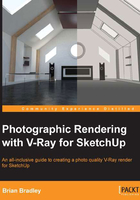
Defining our goals
Before we create any kind of lighting setup in the scene, we need to first of all create our definition or vision regarding what we want to accomplish in our final render(s). At the risk of starting to sound a little repetitive, it is important that we get this created so that it can serve as the guide or blueprint that we use as we move through creating this somewhat different lighting setup.
Observation is crucial
Now, while a definition created entirely from our own imagination can be used as a blueprint for our scene, it isn't generally speaking the best way to go about creating a document that, as we have noted a few times already, is fairly important with regards to the success of the project.
Even if we are working at creating a completely fantastical lighting setup—something that doesn't exist in the real world—we still need to create it based on the reality of how light works. The behavior of light is something that those who view our images will be incredibly familiar with; after all, they see and make use of it every day of their lives, and even though they may not fully understand the physics of how it works, they will instinctively spot mistakes in its behavior.
Once again then, before fixing on the definition that we will use to create the mood or feel for a particular scene, going ahead and gathering reference notes and photographs should be considered an essential part of the process.
In regards to this particular scene, if you have a local gallery or exhibition space that has nighttime sessions (ones that are open to the public, of course), be sure to go along and take notes regarding important elements such as the style of the lighting used and the mood it appears designed to create.
Make a note of the number of light fixtures in the space, the positioning, and even their coloration. If you do find a very particular lighting effect that you realize would look very nice in the render you are trying to create, be sure to document as much about its setup and apparent creation as you possibly can.
If a field trip such as this is not an option, then we can make good use of image searches on the internet, taking the time to compile a varied collection of images that contain different types of lighting fixtures, styles, and feels that we like and that we think will suit the space we are currently working on.
Another option would be to describe in writing or perhaps even capture using a vocal recording, the mood we see being created inside the photographs we are viewing. Keep in mind that one very powerful tool overlooked by many visualization artists is their own emotional reaction to a particular environment or photograph of an environment. By that, I simply mean the way an image strikes you and the feel or mood it suggests to you.
Interior lighting is designed to evoke an automatic emotional response of some sort from us whenever we are present in that space. Obviously, when we are using photographs as a source of reference and inspiration, something of the "automatic" aspect of that response may be missing, which means we may have to work a little harder to capture the feeling that a given lighting solution has been designed to elicit. What we end up with in our lighting designs, however, will often make that little bit of extra effort well worth our while.
My definition for interior nighttime scene lighting
For the sake of speed here, as in the previous chapter, we are going to simply create a very brief text outline of what we want to accomplish with the lighting in this particular chapter.
For this particular space, I would like our renders to have a kind of "after hours" feel to them. The kind of lighting that perhaps only the night guard or maybe VIP's on a special evening tour of the gallery would be likely to see. Indeed, what I have in mind to create will contain way too many areas of shadow or darkness for the lighting scheme to be used when the gallery is open to the public.
This will hopefully give us a nice atmospheric contrast to the bright and airy feel of our previous daylight setup and will also require us to make use of V-Ray's lighting and Global Illumination (GI) tools in quite a different way. This, of course, can only be good practice for us as we work towards becoming familiar with the workings of the V-Ray engine and its tools.